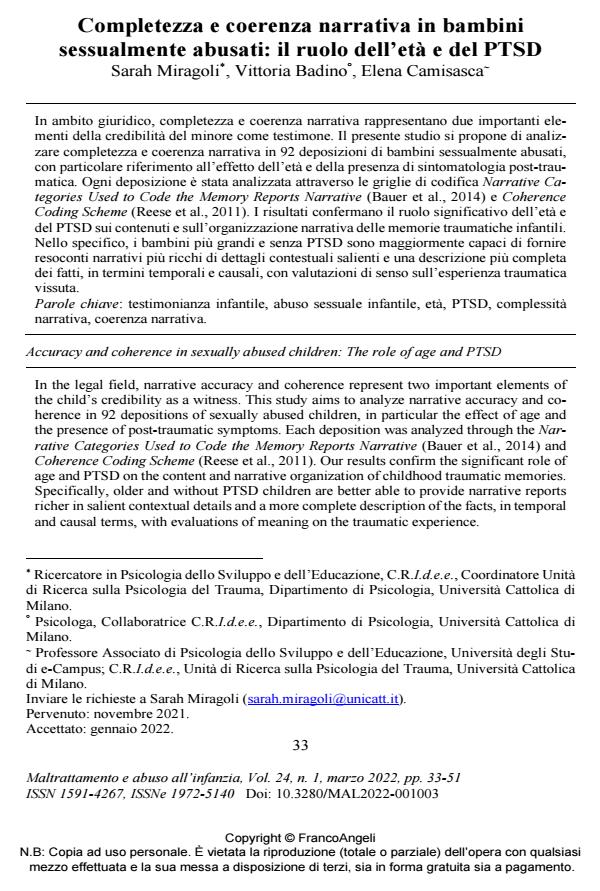Accuracy and coherence in sexually abused children: The role of age and PTSD
Journal title MALTRATTAMENTO E ABUSO ALL’INFANZIA
Author/s Sarah Miragoli, Vittoria Badino, Elena Camisasca
Publishing Year 2022 Issue 2022/1
Language Italian Pages 19 P. 33-51 File size 214 KB
DOI 10.3280/MAL2022-001003
DOI is like a bar code for intellectual property: to have more infomation
click here
Below, you can see the article first page
If you want to buy this article in PDF format, you can do it, following the instructions to buy download credits

FrancoAngeli is member of Publishers International Linking Association, Inc (PILA), a not-for-profit association which run the CrossRef service enabling links to and from online scholarly content.
In the legal field, narrative accuracy and coherence represent two important elements of the child’s credibility as a witness. This study aims to analyze narrative accuracy and coherence in 92 depositions of sexually abused children, in particular the effect of age and the pres-ence of post-traumatic symptoms. Each deposition was analyzed through the Narrative Categories Used to Code the Memory Reports Narrative (Bauer et al., 2014) and Coherence Coding Scheme (Reese et al., 2011). Our results confirm the significant role of age and PTSD on the content and narrative organization of childhood traumatic memories. Specifically, older and without PTSD children are better able to provide narrative reports richer in salient contextual details and a more complete description of the facts, in temporal and causal terms, with evaluations of meaning on the traumatic experience.
Keywords: child testimony, Child Sexual Abuse, age, PTSD, narrative accuracy, narrative coherence.
- Coherence of child maltreatment narratives by emerging adults: How does child maltreatment affect how we share our story? Mariam Fishere, Tilmann Habermas, in Applied Cognitive Psychology /2023 pp.531
DOI: 10.1002/acp.4056 - Le violenze sui minorenni in ambito sportivo: inquadramento del fenomeno, dati di prevalenza e best practices Maria Cristina Verrocchio, in MALTRATTAMENTO E ABUSO ALL'INFANZIA 3/2024 pp.7
DOI: 10.3280/MAL2023-003001
Sarah Miragoli, Vittoria Badino, Elena Camisasca, Completezza e coerenza narrativa in bambini sessualmente abusati: il ruolo dell’età e del PTSD in "MALTRATTAMENTO E ABUSO ALL’INFANZIA" 1/2022, pp 33-51, DOI: 10.3280/MAL2022-001003